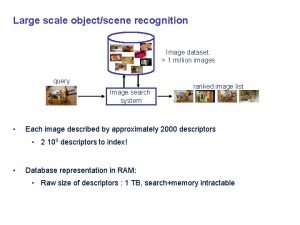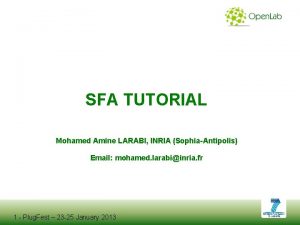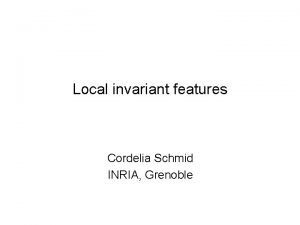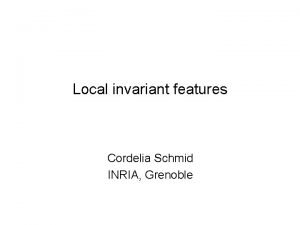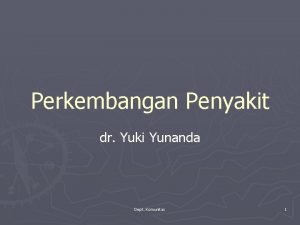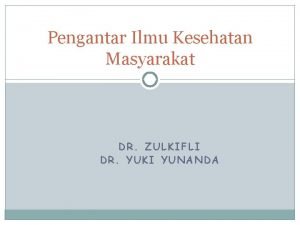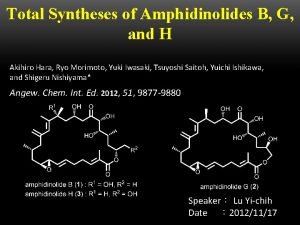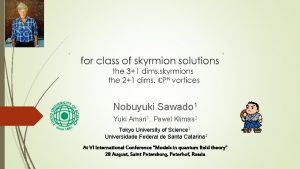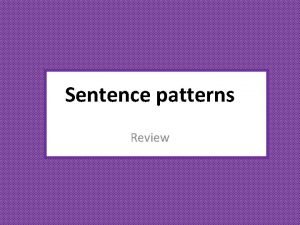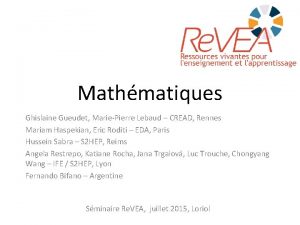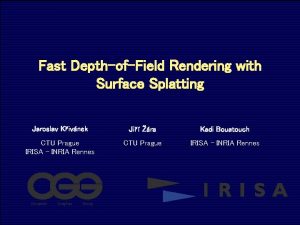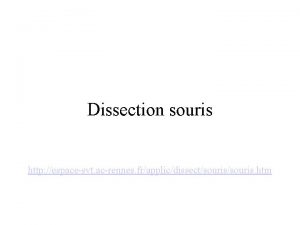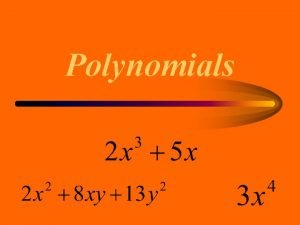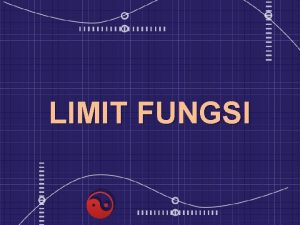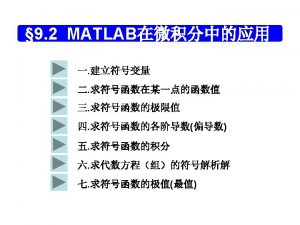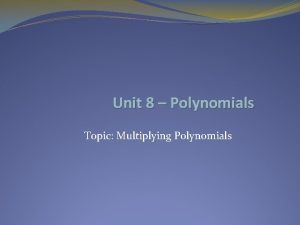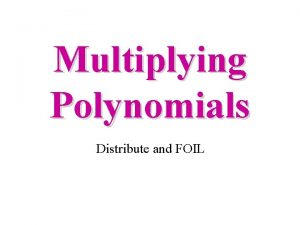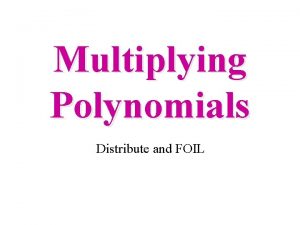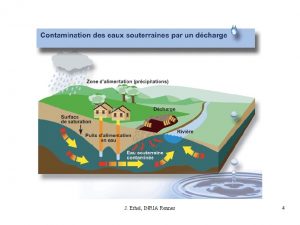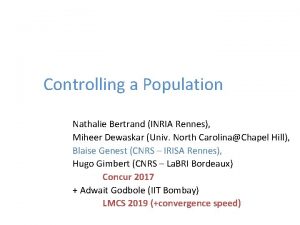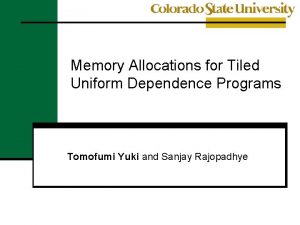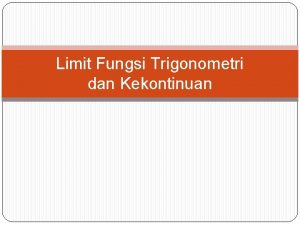The Limit of Polynomials Tomofumi Yuki INRIA Rennes










![Ex 1: Farkas’ Lemma n D: x∈[-1, 1] n x+1≥ 0 n 1 -x≥ Ex 1: Farkas’ Lemma n D: x∈[-1, 1] n x+1≥ 0 n 1 -x≥](https://slidetodoc.com/presentation_image/346cb0d0173da57f6d9ef7db5a454cbc/image-11.jpg)
![Ex 2: Handelman’s Theorem n D: x∈[-1, 1] n x+1≥ 0 n 1 -x≥ Ex 2: Handelman’s Theorem n D: x∈[-1, 1] n x+1≥ 0 n 1 -x≥](https://slidetodoc.com/presentation_image/346cb0d0173da57f6d9ef7db5a454cbc/image-12.jpg)


![Ex 4: Strict Positivity n Test for x 2 instead n D: x∈[-1, 1] Ex 4: Strict Positivity n Test for x 2 instead n D: x∈[-1, 1]](https://slidetodoc.com/presentation_image/346cb0d0173da57f6d9ef7db5a454cbc/image-15.jpg)



![Ex 5: Finding the Minimum Value n D: x∈[-1, 1] x-x 2 n Find: Ex 5: Finding the Minimum Value n D: x∈[-1, 1] x-x 2 n Find:](https://slidetodoc.com/presentation_image/346cb0d0173da57f6d9ef7db5a454cbc/image-19.jpg)
![Ex 5: Finding the Minimum Value n D: x∈[-1, 1] x-x 2 n Find: Ex 5: Finding the Minimum Value n D: x∈[-1, 1] x-x 2 n Find:](https://slidetodoc.com/presentation_image/346cb0d0173da57f6d9ef7db5a454cbc/image-20.jpg)
![Ex 5: Finding the Minimum Value n D: x∈[-1, 1] x-x 2 n Find: Ex 5: Finding the Minimum Value n D: x∈[-1, 1] x-x 2 n Find:](https://slidetodoc.com/presentation_image/346cb0d0173da57f6d9ef7db5a454cbc/image-21.jpg)
![Ex 5: Finding the Minimum Value n D: x∈[-1, 1] x-x 2 n Find: Ex 5: Finding the Minimum Value n D: x∈[-1, 1] x-x 2 n Find:](https://slidetodoc.com/presentation_image/346cb0d0173da57f6d9ef7db5a454cbc/image-22.jpg)










![Problem with Parameters n D: x∈[-N, N]; Find: x 2+1 n family of D Problem with Parameters n D: x∈[-N, N]; Find: x 2+1 n family of D](https://slidetodoc.com/presentation_image/346cb0d0173da57f6d9ef7db5a454cbc/image-33.jpg)
![Parametric Solutions are Possible n D: x∈[-N, N]; Find: x 2+N 2 n All Parametric Solutions are Possible n D: x∈[-N, N]; Find: x 2+N 2 n All](https://slidetodoc.com/presentation_image/346cb0d0173da57f6d9ef7db5a454cbc/image-34.jpg)






- Slides: 40

The Limit of Polynomials Tomofumi Yuki INRIA Rennes

Acknowledgements n Interesting discussions about polynomials n Paul Feautrier n Steven Derrien n Silviu-Ioan Filip n Year-Long Student Project n Adrien Chaffangeon n Adrien Gougeon n Timothee Anne IMPACT 2019 2

Limits of the Polyhedral Model n Strong framework for: n dependence analysis n program transformation n code generation n. . . n Strong limitation in exchange: n everything must be affine IMPACT 2019 3

Polynomial Extensions n Extend the class of functions (Feautrier 2015) n affine to polynomial n Lift restrictions of the polyhedral model: n polynomial scheduling n non-linear array accesses (e. g. , A[i*N+j]) n parametric tiling n + some work on code gen (IMPACT 2018) IMPACT 2019 4

Affine Scheduling n Ordering of operations n assign time stamps (affine functions) n model of loop transformations n dependences must be respected for (i = 1: N) for (j = 1: N) S 1(i, j); for (i = 1: N) S 2(i); Domain S 1: {i, j|1≤i≤N, 1≤j≤N} S 2: {i|1≤i≤N} for (i = 1: N) for (j = 1: N) S 1(i, j); S 2(i); Schedule sch 1(i, j) = (i, j) sch 2(i) = (i, N+1) IMPACT 2019 5

Farkas’ Lemma n Given polyhedral set D and affine function f is non-negative over D n iff f can be expressed as a linear combination of constraints defining D n Scheduling ≈ Positivity Check sch 1(op 1) > sch 2(op 2) f(op 1, op 2) > 0 n op 1 and op 2 are defined with polyhedral sets IMPACT 2019 6

Polynomial Scheduling n Handelman’s Theorem (simplified) n Given a polynomial f, and a set n f is strictly positive on D n iff it has the following representation Handelman Representation: linear combination of products of constraints IMPACT 2019 7

Two Research Questions n When do we need polynomial scheduling? n multi-dimensional affine is quite powerful Set Splitting? n static but. Index non-affine programs? n What are the implications of replacing Farkas’ Lemma with Handelman’s Theorem? non-negative / strictly positive n unbounded D / bounded D n No bound on degree of constraint products n IMPACT 2019 8

Implications for Scheduling n A class of polynomials does not have exact Handelman representation (Lasserre 2002) n Polynomial Scheduling Caveats: n a class of schedules is not explored n effectively acts as non-negativity certificate n constant matters Jean B. Lasserre. 2002. Semidefinite Programming vs. LP Relaxations for Polynomial Programming. Mathematics of Operations Research IMPACT 2019 9

Outline n Introduction n Farkas vs Handelman n Polynomial Optimization n Lasserre’s Results n Parametric Domains n Conclusion IMPACT 2019 10
![Ex 1 Farkas Lemma n D x1 1 n x1 0 n 1 x Ex 1: Farkas’ Lemma n D: x∈[-1, 1] n x+1≥ 0 n 1 -x≥](https://slidetodoc.com/presentation_image/346cb0d0173da57f6d9ef7db5a454cbc/image-11.jpg)
Ex 1: Farkas’ Lemma n D: x∈[-1, 1] n x+1≥ 0 n 1 -x≥ 0 2 x+1 n Test if 2 x+1 is positive in D n Can 2 x+1 be expressed as n a(x+1)+b(1 -x)+c n where a, b, c≥ 0? 1 1 n No: 2 x+1 is not non-negative in D IMPACT 2019 11
![Ex 2 Handelmans Theorem n D x1 1 n x1 0 n 1 x Ex 2: Handelman’s Theorem n D: x∈[-1, 1] n x+1≥ 0 n 1 -x≥](https://slidetodoc.com/presentation_image/346cb0d0173da57f6d9ef7db5a454cbc/image-12.jpg)
Ex 2: Handelman’s Theorem n D: x∈[-1, 1] n x+1≥ 0 n 1 -x≥ 0 x 2+1 n Test if x 2+1 is positive in D n Consider degree 2 products: 1 [1, x+1, 1 -x, (x+1)2, (1 -x)2, (x+1)(1 -x)] 1 n Can x 2+1 be expressed with above? n Yes: (x+1)2+(1 -x)2 = 2 x 2+2 n 0. 5(x+1)2+0. 5(1 -x)2 = x 2+1 IMPACT 2019 12

Key Differences n The set D must be compact n not the case for Farkas’ Lemma n Potentially infinitely many terms n products of constraints introduce more terms n in practice: bound the degree (Σki) n Strict positivity n representation should give non-negativity IMPACT 2019 13

Ex 3: Degree Bound on Products n Same test with different D x 2+1 n D: x∈[-2, 2] n x+2≥ 0 n 2 -x≥ 0 n Consider degree 2 products: 2 [1, x+2, 2 -x, (x+2)2, (2 -x)2, (x+2)(2 -x)] 2 n Can x 2+1 be expressed with above? n No: need degree 5 products IMPACT 2019 14
![Ex 4 Strict Positivity n Test for x 2 instead n D x1 1 Ex 4: Strict Positivity n Test for x 2 instead n D: x∈[-1, 1]](https://slidetodoc.com/presentation_image/346cb0d0173da57f6d9ef7db5a454cbc/image-15.jpg)
Ex 4: Strict Positivity n Test for x 2 instead n D: x∈[-1, 1] n x+1≥ 0 n 1 -x≥ 0 x 2 n Consider degree 2 products: 1 [1, x+1, 1 -x, (x+1)2, (1 -x)2, (x+1)(1 -x)] 1 n Can x 2 be expressed with above? n No: you cannot express x 2 n even with high degree products IMPACT 2019 15

How is Scheduling Affected? n Polynomial Scheduling seems to “work” n but not the same as Farkas Scheduling n the impact of differences is unclear n Some answers from Polynomial Optimization n main results by Jean-Bernard Lasserre IMPACT 2019 16

Outline n Introduction n Farkas vs Handelman n Polynomial Optimization n Lasserre’s Results n Parametric Domains n Conclusion IMPACT 2019 17

Polynomial Optimization n Find the minimal value of a polynomial over a domain n links to positivity checks z 1 1 n Recall: positivity checks characterize positive functions over a domain IMPACT 2019 18
![Ex 5 Finding the Minimum Value n D x1 1 xx 2 n Find Ex 5: Finding the Minimum Value n D: x∈[-1, 1] x-x 2 n Find:](https://slidetodoc.com/presentation_image/346cb0d0173da57f6d9ef7db5a454cbc/image-19.jpg)
Ex 5: Finding the Minimum Value n D: x∈[-1, 1] x-x 2 n Find: min x-x 2 n Consider degree 2 products: 1 x+1 1 -x (x+1)2 (1 -x)2 (x+1)(1 -x) 1 1 IMPACT 2019 19
![Ex 5 Finding the Minimum Value n D x1 1 xx 2 n Find Ex 5: Finding the Minimum Value n D: x∈[-1, 1] x-x 2 n Find:](https://slidetodoc.com/presentation_image/346cb0d0173da57f6d9ef7db5a454cbc/image-20.jpg)
Ex 5: Finding the Minimum Value n D: x∈[-1, 1] x-x 2 n Find: min x-x 2 n Their linear combination: λ 0 + λ 1(x+1) + λ 2(1 -x) + λ 3(x+1)2 + λ 4(1 -x)2 + λ 5(x+1)(1 -x) 1 1 IMPACT 2019 20
![Ex 5 Finding the Minimum Value n D x1 1 xx 2 n Find Ex 5: Finding the Minimum Value n D: x∈[-1, 1] x-x 2 n Find:](https://slidetodoc.com/presentation_image/346cb0d0173da57f6d9ef7db5a454cbc/image-21.jpg)
Ex 5: Finding the Minimum Value n D: x∈[-1, 1] x-x 2 n Find: min x-x 2 n Expand the squares: λ 0 + λ 1(x+1) + λ 2(1 -x) + λ 3(x 2+2 x+1) + λ 4(x 2 -2 x+1) + λ 5(-x 2+1) 1 1 IMPACT 2019 21
![Ex 5 Finding the Minimum Value n D x1 1 xx 2 n Find Ex 5: Finding the Minimum Value n D: x∈[-1, 1] x-x 2 n Find:](https://slidetodoc.com/presentation_image/346cb0d0173da57f6d9ef7db5a454cbc/image-22.jpg)
Ex 5: Finding the Minimum Value n D: x∈[-1, 1] x-x 2 n Find: min x-x 2 1 n Factor by monomials: 1 (λ 0+λ 1+λ 2+λ 3+λ 4+λ 5) + x 2(λ 3+λ 4 -λ 5) min =1 + x (λ 1 -λ 2+2λ 3 -2λ 4) 1 =-1 λ 1=λ 5=1 x-x 2≥-2 IMPACT 2019 22

Ex 6: Finding the Minimum #2 n Find: min x 2 -x n Minimum is -0. 25 n Solution with different degrees: Degree 2 4 8 Solution -0. 5 -0. 333 -0. 286 16 32 -0. 267 -0. 258 1 1 fixed degree lower bound (relaxation to LP) NEVER reaches -0. 25!! IMPACT 2019 23

Lasserre’s Theorem n When exact solutions can be found n Theorem 3. 1 (Lasserre 2002) n M: bound on degree of constraint products n For a class of polynomials, solution to the relaxed problem approaches the exact solution as M→∞ (i. e. , never reached) n The class in question: n When a global minimizer is at the interior of D IMPACT 2019 24

Back to Ex 5 and Ex 6 n Ex 6 has its minimizer at the interior of D Ex 5 1 Ex 6 x-x 2 x 2 -x 1 1 1 minimizers IMPACT 2019 25

What Does it Mean? n A class of polynomials cannot be found with polynomial scheduling n Example: x 2 for x∈[-1, 1] n x 2+1 needs M=2 n x 2+0. 25 needs M=5 n x 2 needs M=∞ x 2 n 1 1 n x 2 can never be found! n expressing x 2+c harder as c→ 0 IMPACT 2019 26

Relation to Strict Positivity n Lasserre’s Theorem shows when strict positivity in Handelman’s Theorem manifest n comes from M→∞ n The following are equivalent: Exact Solution to Polynomial Optimization Non-Negativity Certificate with Handelman n both require minimizers to be at the boundary IMPACT 2019 27

Back to Ex 5 and Ex 6 Again n Non-Negativity Certificate only for Ex 5 1 x-x 2+2≥ 0 Ex 6 x-x 2 x 2 -x 1 1 1 x 2 -x+0. 25+ε≥ 0 -x+0. 25>0 IMPACT 2019 28

What it Means for Scheduling n If Handelman Representation can be found with some M depends a lot on the polynomial n exploration space is sparse n Some are not expressible: n non-negative polynomials with global minimizer at interior n Constant Matters: n smaller constant need higher M IMPACT 2019 29

Optimization vs Scheduling n One subtle difference: n no constants in optimization context n Minimizer can be at the interior for scheduling x 2+1 1 1 x 2+1 found with M=2 x 2≥-1 is not exact LB of x 2 need “sufficiently high” M depending on the constant IMPACT 2019 30

Outline n Introduction n Farkas vs Handelman n Polynomial Optimization n Lasserre’s Results n Parametric Domains n Conclusion IMPACT 2019 31

On Parametric Domains n Everything so far: when set D is compact n matches hypotheses of Handelman’s Theorem n We use parametric domains all the time n usually not compact n Can we still use Handelman’s Theorem? IMPACT 2019 32
![Problem with Parameters n D xN N Find x 21 n family of D Problem with Parameters n D: x∈[-N, N]; Find: x 2+1 n family of D](https://slidetodoc.com/presentation_image/346cb0d0173da57f6d9ef7db5a454cbc/image-33.jpg)
Problem with Parameters n D: x∈[-N, N]; Find: x 2+1 n family of D [-1, 1], [-2, 2], . . . n Every instance can be scaled to [-1, 1] x 2+0. 25 x 2+1 2 1 n Harder problem with higher values of N 2+1 for x∈[-N, N] n N→∞ x 2 for xx∈[-1, 1] No hope≈offinding IMPACT 2019 33
![Parametric Solutions are Possible n D xN N Find x 2N 2 n All Parametric Solutions are Possible n D: x∈[-N, N]; Find: x 2+N 2 n All](https://slidetodoc.com/presentation_image/346cb0d0173da57f6d9ef7db5a454cbc/image-34.jpg)
Parametric Solutions are Possible n D: x∈[-N, N]; Find: x 2+N 2 n All instances are equivalent: x 2+1 1 1 x 2+4 2 2 x 2+9 3 3 n x 2+N 2 can be found with M=2 n (x+N)2+(N-x)2 = 2 x 2+2 N 2 n solution for N=1 can be made parametric IMPACT 2019 34

Impact of Parameters n Further reduce the space of polynomials n the same linear combination must work for all parameter instances need monomials involving parameters n Example: x∈[-1, 1] x 2+1 x 2+0. 25 x 2 M 2 5 ∞ x∈[-N, N] x 2+N 2 x 2+0. 25 N 2 x 2 IMPACT 2019 35

Conclusion n Closer look into what it means to use Handelman’s Theorem for scheduling a good chunk of the space is excluded n especially with parameters n can be treated as non-negativity certificate n n Completely skipped ISS part! n led me to try and find polynomials with global minimizers at interior IMPACT 2019 36

Semi-Definite Programming? n SDP relxation n another approach to Polynomial Optimization n sum of squares instead of linear combination n Lasserre’s paper was about LP vs SDP n SDP is better! n Can we use SDP approach for scheduling? n seems promising n but compactness hypotheses remain IMPACT 2019 37

IMPACT 2019 38

Index-Set Splitting n Dependence Graph n no affine schedule n need PW-affine n Main reason: n affine function cannot change “direction” IMPACT 2019 39

Polynomial Guided ISS n Polynomials are multi-directional: j n e. g. , x 2 n Main idea: n first find a polynomial schedule n analyze polynomial n infer necessary pieces n Example: n (i-j)2 split at i=j i IMPACT 2019 40
 Tomofumi tanizawa kimi ni todoke
Tomofumi tanizawa kimi ni todoke Inria holidays dataset
Inria holidays dataset Sfa email
Sfa email Cordelia schmid
Cordelia schmid Cordelia schmid
Cordelia schmid Upper specification limit and lower specification limit
Upper specification limit and lower specification limit Natural variations operations management
Natural variations operations management Grafik limit fungsi
Grafik limit fungsi Dr yuki yunanda
Dr yuki yunanda Dr yuki yunanda
Dr yuki yunanda Datamodel yuki
Datamodel yuki Takeshi fujiwara
Takeshi fujiwara Yuki takai
Yuki takai Aaron fyke
Aaron fyke Pawel klimas
Pawel klimas Zenbu de ikura desu ka
Zenbu de ikura desu ka Yuki kernel
Yuki kernel Aaron fyke
Aaron fyke Bed pfp
Bed pfp Dr pierre lebaud
Dr pierre lebaud Cursus rennes 2
Cursus rennes 2 Rennes métropole
Rennes métropole Surface zara rennes
Surface zara rennes Bibliothèque champs manceaux rennes
Bibliothèque champs manceaux rennes Thomas cook voyages 9 rue du puits mauger 35000 rennes
Thomas cook voyages 9 rue du puits mauger 35000 rennes Domoticiens rennes
Domoticiens rennes Appareil génital souris femelle
Appareil génital souris femelle Alfadi rennes
Alfadi rennes Arena sableuse
Arena sableuse Publinet rennes
Publinet rennes Ent rennes 1
Ent rennes 1 Conseil dynamiser collaborateurs rennes
Conseil dynamiser collaborateurs rennes Ose rennes1
Ose rennes1 Crcc angers
Crcc angers Extensiline
Extensiline Tư thế ngồi viết
Tư thế ngồi viết Thứ tự các dấu thăng giáng ở hóa biểu
Thứ tự các dấu thăng giáng ở hóa biểu Thẻ vin
Thẻ vin Thể thơ truyền thống
Thể thơ truyền thống Hát lên người ơi
Hát lên người ơi Hươu thường đẻ mỗi lứa mấy con
Hươu thường đẻ mỗi lứa mấy con

